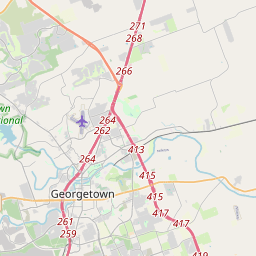City of Weir
Historical marker location:






Tenessee-native Thomas Calvin Weir (1826-1901) came to Williamson County in 1856. He bought land in this area and became a prosperous farmer. Alabaman James Francis Towns (1850-1937) came in 1870 and settled nearby on the San Gabriel River. He and his brother, Robert W. Towns (1848-1938), operated a gin and blacksmith shop, as well as Towns' Mill.
In the late 19th century, the communities of Weir and Townsville (or Towns' Mill) grew around these early settlers. Churches included Baptist and Presbyterian congregations that met at the Prairie Springs School, as well as an African American church that met in a school near Mankins Crossing. Calvin Weir's daughter, Lucy, served as postmaster at the post office in Townsville, where she also ran a small store.
The communities developed similarly until 1893, when the Georgetown and Granger Railrad came through Weir, bypassing Townsville. In 1903, after the Missouri, Kansas and Texas Railroad (MKT) bought the line, known as the Katy, most area residents moved into the town of Weir, officially established that same year. The Katy Lake Resory, created by MKT on the river at Towns' Mill Dam, attracted tourists to the area. The Townsville
post office moved to Weir, and with several new businesses, the town began to thrive.
A flood in 1913 damaged the resort and several local businesses, and after a severe drought, World War I and the Great Depression, Weir's population faltered but began to prosber again in the mid-20th century. Following voter approval, Weir incorporated as a city in 1987. (2002)
As one of the most visible programs of the Texas Historical Commission (THC), historical markers commemorate diverse topics in Texas history, including: the history and architecture of houses, commercial and public buildings, religious congregations, and military sites; events that changed the course of local and state history; and individuals who have made lasting contributions to the state, community organizations, and businesses.
The state of Texas was once an independent country known as the Republic of Texas. It gained independence from Mexico in 1836 and was a separate nation until it was annexed by the United States in 1845.
The region was first settled by European pioneers in the mid-19th century. The establishment of Fort Tumlinson in 1839 provided protection to settlers, and the population grew steadily with the arrival of more immigrants in search of new opportunities. In 1848, the county was officially organized and named after Robert McAlpin Williamson, a judge and soldier in the Republic of Texas.
During the Civil War, Williamson County faced significant challenges. Many residents joined the Confederate Army, and the county became a hotbed of conflict due to its location on the frontier between Union and Confederate territories. After the war, the area was able to rebuild and experienced a period of economic growth, driven by agriculture, cattle ranching, and the emergence of small towns and rural communities.
In the 20th century, Williamson County continued to develop and adapt to changing times. The discovery of oil in the early 1900s brought economic prosperity to the region, and the county experienced a boom in population and infrastructure. Today, Williamson County is a thriving part of the greater Austin metropolitan area, known for its strong economy, vibrant communities, and commitment to preserving its historical roots.
Williamson County Timeline
This timeline provides a concise overview of the key events in the history of Williamson County, Texas.
- 1804 - The area that is now Williamson County is settled by Native American tribes, including the Tonkawa, Lipan Apache, and Comanche.
- 1836 - Texas gains independence from Mexico.
- 1838 - The Texas legislature establishes Williamson County, named after Robert McAlpin Williamson, a leader in the fight for Texas independence.
- 1848 - The Mexican-American War ends and the Treaty of Guadalupe Hidalgo is signed, officially establishing the Rio Grande as the boundary between Texas and Mexico.
- 1850 - The population of the county reaches 1,027.
- 1876 - The Texas State Capitol building is completed in Austin, which becomes the seat of government for Williamson County.
- 1881 - The International-Great Northern Railroad reaches Georgetown, bringing economic growth and development to the county.
- 1907 - The county courthouse, located in Georgetown, is completed.
- 1930s - The Great Depression hits Williamson County, causing a decline in the local economy.
- 1950s - The county experiences a period of growth and prosperity, with the population increasing significantly.
- 1990s - Development and suburbanization accelerate in Williamson County, with the county becoming one of the fastest-growing areas in the United States.